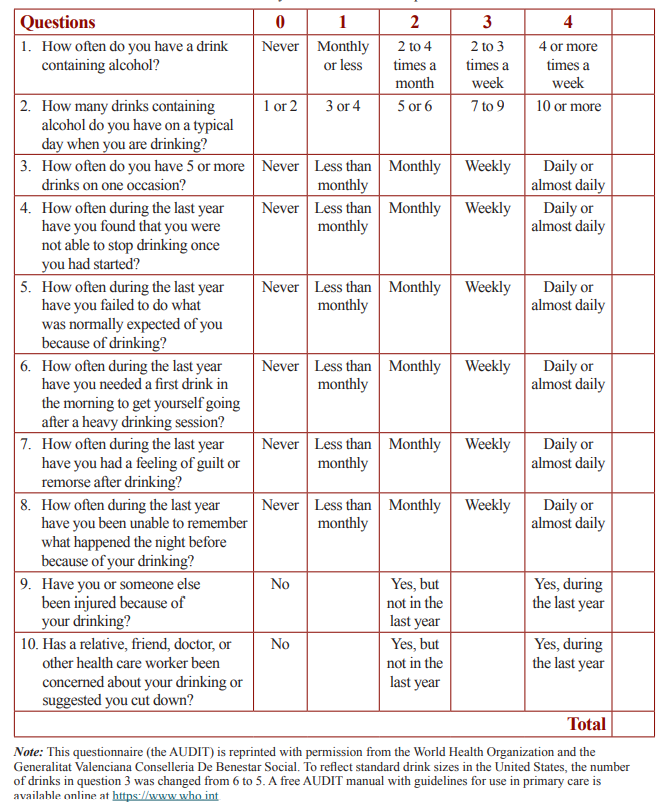Additional Workup Resources
Using the quick two-question screening tool and risk level estimates in this Guide, you’ll have
a good idea as to your patients’ level of risk for alcohol-related problems. You can further gauge
the risk level and need for referral by asking more questions, as suggested on page 10, by using a
formal tool, or both.
Two short tools to consider are the Alcohol Use Disorders Identification Test (AUDIT), which
delves more deeply into alcohol-related behaviors, and the CRAFFT, explained below, which
inquires about other drug use in addition to alcohol use. Both the AUDIT and the CRAFFT can be
used as a paper–pencil or electronic screen, and the CRAFFT can be verbally administered. Both
identify problems that can be discussed during motivational interviewing. And both should, of
course, be administered with patient privacy protected.
The 10-question AUDIT instrument, available on the next page, was designed for use with adults
and may be appropriate for adolescents, as well (Reinert & Allen, 2007). The AUDIT’s validity
has been consistently confirmed in adults (Reinert & Allen, 2007). Research also supports use of
the AUDIT for adolescents ages 14 to 18, with lower cut points of 2 for identifying any alcohol
problem use and 3 for alcohol abuse or dependence (Knight et al., 2003).
You may be familiar with the CRAFFT tool, which is incorporated into the American Academy
of Pediatrics Policy Statement on Substance Use Screening, Brief Intervention, and Referral
to Treatment for Pediatricians (AAP Committee on Substance Abuse, 2016). The CRAFFT
identifies adolescent alcohol and drug use and associated behaviors. Research indicates that a
“yes” to two of the questions below signals a problem needing further evaluation and that a score
of 4 or more “should raise suspicion of substance dependence” (Knight et al., 2002):
C: Have you ever ridden in a CAR driven by someone (including yourself) who was “high”
or had been using alcohol or drugs?
R: Do you ever use alcohol or drugs to RELAX, feel better about yourself, or fit in?
A: Do you ever use alcohol or drugs while you are by yourself, ALONE?
F: Do you ever FORGET things you did while using alcohol or drugs?
F: Do your family or FRIENDS ever tell you that you should cut down on your drinking or
drug use?
T: Have you ever gotten into TROUBLE while you were using alcohol or drugs?
Along with the two-question screener in this Guide, these tools fit well with broader based,
structured psychosocial interview schemes such as the HEADSS (questions about home,
education, activities, drug and alcohol use, sexuality, and suicide) and interviews that add
a focus on strengths that may help offset risks. The American Academy of Pediatrics notes:
“Structured tools can be easily incorporated into the written or electronic health record to remind
the practitioner to conduct screening and document the results” (AAP Committee on Substance
Abuse, 2016).
Patient: Because alcohol use can affect your health and can interfere with certain medications
and treatments, it is important that we ask some questions about your use of alcohol. Your
answers will remain confidential, so please be honest.
Place an X in one box that best describes your answer to each question.

